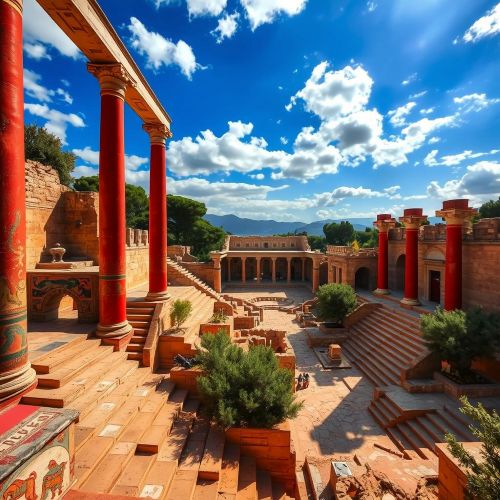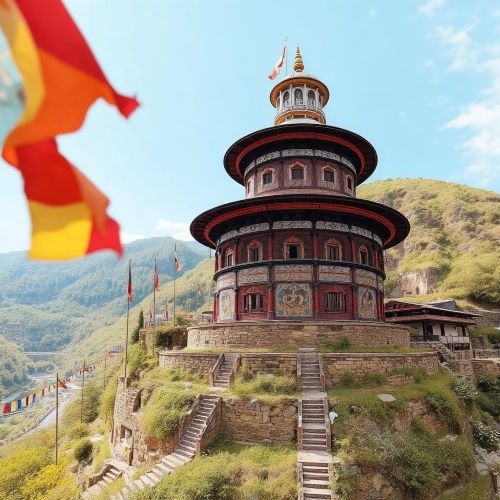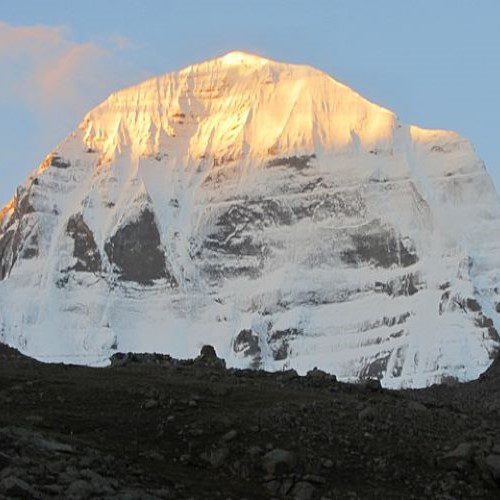Potala Palace : The Tibetan Beacon
At a glance
| Description | |
|---|---|
| Mythology | Tibetan Mythology |
| Country | Tibet (China) |
| Closest airport | Lhasa Gonggar Airport (LXA) |
| Type | Constructed |
| Accessibility | 10/10 |
Introduction
Rising dramatically above the city of Lhasa on the Red Hill, the Potala Palace is one of the world’s most iconic landmarks. More than a striking architectural feat, it is a living chronicle of Tibet’s history, faith, and resilience. Towering 13 stories high with over 1,000 rooms, the palace once served as the political and spiritual heart of Tibet for centuries. From the 7th century beginnings under King Songtsen Gampo to its later grandeur shaped by the Fifth Dalai Lama, Potala Palace remains an enduring emblem of Tibetan identity. Today, it is a UNESCO World Heritage Site, attracting pilgrims, historians, and travelers from across the globe who wish to witness its spiritual aura and cultural splendor.
Connection with Mythology
The Potala Palace’s name is rooted in the sacred Mount Potalaka, believed to be the mythical home of Avalokiteśvara, the Bodhisattva of Compassion. Tibetan legend holds that King Songtsen Gampo, considered an earthly incarnation of Avalokiteśvara, chose this hill for meditation long before the palace’s construction. These meditation caves, still preserved within the structure, became the spiritual foundation upon which the palace rose.
The Fifth Dalai Lama expanded the site with the belief that its placement harmonized with geomantic principles, aligning it with divine energies. Inside, chapels and murals weave together mythic narratives and Buddhist cosmology, portraying deities, spiritual realms, and the compassionate mission of Avalokiteśvara. This fusion of myth and history ensures that the palace is not just a monument but a living bridge between the human world and the sacred.
Ways to Get There
Reaching the Potala Palace requires both logistical preparation and, for many visitors, a degree of acclimatization to Lhasa’s 3,700-meter altitude.
For international travelers, the most common entry point is Lhasa Gonggar Airport, located about 60 kilometers from the city center. Shuttle buses operate regularly, offering an affordable and scenic journey into Lhasa, while taxis provide a quicker but more expensive option. Another popular route is the Qinghai–Tibet Railway, celebrated for its panoramic views of the Tibetan Plateau. Arriving at Lhasa Railway Station, visitors can take a short taxi ride directly to the palace area.
Within Lhasa itself, walking from Barkhor Street or Jokhang Temple to the palace is a rewarding experience, as it offers glimpses of daily Tibetan life and streams of pilgrims making their way to the site. Public buses stop near the palace entrance, and guided tours—mandatory for most foreign visitors—often include transport, entrance arrangements, and historical briefings.
What to Look For
The Potala Palace is a vast complex divided into two main sections, each revealing a different facet of its history and purpose.
The White Palace, or Potrang Karpo, once served as the living quarters and administrative hub for the Dalai Lamas. Visitors can explore grand reception halls, sunlit chambers, and the Coqen Hall, where official ceremonies took place. The intricate woodwork, painted beams, and murals offer insight into Tibetan artistry at its peak.
Above it stands the Red Palace, or Potrang Marpo, devoted entirely to religious functions. Here, golden stupas enshrine the remains of past Dalai Lamas, and chapels display thousands of statues, thangkas, and sacred texts. The Great West Hall captivates with murals narrating the life of the Fifth Dalai Lama and pivotal moments in Tibetan history.
Beyond the interiors, the palace’s golden rooftops glisten in the sunlight, offering breathtaking views of the Lhasa Valley. Around the complex, prayer wheels, incense burners, and carved stone walls create an immersive spiritual atmosphere. The architecture itself—massive stone walls, intricately carved windows, and tiered courtyards—is a testament to Tibetan craftsmanship and resilience against the harsh Himalayan climate.
Importance in cultural history
For centuries, the Potala Palace stood as the epicenter of both governance and spirituality in Tibet. From 1649 until 1959, it was the winter residence of the Dalai Lamas, a place where religious rituals intertwined with political decision-making. The palace symbolized the unity of temporal and spiritual power, a defining feature of Tibetan society.
Architecturally, it represents the zenith of Tibetan design, blending influences from India and China while remaining distinctly Tibetan in identity. Built from local stone, timber, and rammed earth, its design reflects an understanding of both aesthetics and function, ensuring stability against earthquakes and severe weather.
Its recognition as a UNESCO World Heritage Site in 1994 acknowledged not only its architectural mastery but also its cultural and historical significance. Inside, thousands of cultural relics—from handwritten sutras to jewel-encrusted statues—document centuries of Tibetan life, spirituality, and artistry. For Tibetans and Buddhists worldwide, the palace remains a place of pilgrimage, its image often reproduced in art and prayer materials as a symbol of faith.
Best time to travel
Choosing the right time to visit Potala Palace can greatly enhance the experience.
Spring (April to June) brings mild weather and blooming landscapes, making it perfect for photography and outdoor exploration. The clear skies allow for spectacular views of the palace against snow-dusted peaks.
Autumn (September to October) offers similar conditions, with crisp air and golden light bathing the Red Hill, creating an almost ethereal scene. These months also align with some of Tibet’s vibrant festivals, adding a cultural dimension to the visit.
Summer (July to August) is the peak tourist season, often coinciding with events like the Shoton Festival, when the palace becomes a focal point for celebrations. However, this period can also bring heavier crowds and occasional monsoon showers.
Winter (November to March) transforms the palace into a serene sanctuary, with fewer visitors and a calmer atmosphere. Snow occasionally dusts its roofs and courtyards, creating postcard-worthy scenes. The intense sunlight in Lhasa during winter offsets the cold, and the season offers discounted entry fees. Pilgrims arrive in greater numbers during this time, heightening the spiritual ambiance.
No matter the season, visitors should allow at least a day in Lhasa before ascending to the palace to adjust to the altitude. Comfortable walking shoes, layered clothing, sunscreen, and respect for local customs are essential for a rewarding visit.
Source
Himalayan Glacier. (2025, July 8). Potala Palace: Unraveling the Architectural Marvel of Tibet. https://www.himalayanglacier.com/potala-palace/
Xiao, D. (2021, November 30). The Potala Palace in Tibet | Journal of Student Research. https://www.jsr.org/hs/index.php/path/article/view/2340
UNESCO World Heritage Centre. (n.d.). Historic Ensemble of the Potala Palace, Lhasa. https://whc.unesco.org/en/list/707/
Odynovotours. (2024, May 22). Potala Palace Travel Guide: history, inside, travel tips. https://www.odynovotours.com/china/tibet/potala-palace.html
Audley Travel US. (2022, March 21). Potala Palace Visit, Tibet. https://www.audleytravel.com/us/tibet/things-to-do/visit-to-the-potala-palace
China Odyssey Tours. (2025, July 8). Your Guide to Potala Palace: Highlights & Travel Tips. https://www.chinaodysseytours.com/tibet/tibet-potala-palace.html
Tibet Travel. (2025, June 24). Potala Palace in Winter: More Majestic, Religious and …. https://www.tibettravel.org/tibet-travel-guide/potala-palace-in-winter.html
Vetter, J. (2020). Through the eyes of the Potala Palace: Difficult heritage …. https://theijournal.ca/index.php/ijournal/article/view/35270/26999
Tibet Vista. (n.d.). Top 10 Things to Do for Visiting the Potala Palace – Tibet Vista. https://www.tibettravel.org/tibet-travel-guide/things-to-do-potala-palace.html
Tibet Travel. (2025, July 31). Top 10 Things to Do for Visiting the Potala Palace. https://www.tibettravel.org/tibet-travel-guide/things-to-do-potala-palace.html
Wikipedia. (n.d.). Potala Palace. https://en.wikipedia.org/wiki/Potala_Palace
Tibet Travel. (n.d.). Potala Palace in Lhasa, Tibet. https://www.tibettravel.org/tibet-travel-guide/potala-palace/
Original Buddhas. (n.d.). The Potala Palace, the former residence of many Dalai Lamas. https://www.originalbuddhas.com/blog/the-potala-palace?srsltid=AfmBOorKAwEX-yK3h_5qKA2Qfwhs6DLlFn2lLvGlskV5c74l51iPYka1
The Trekkers Society. (n.d.). Potala Palace – Lhasa – The Trekkers Society. https://www.trekkerssociety.com/potala-palace-lhasa
Everest Nepal Tours. (n.d.). Majestic Potala Palace and Tibetan Spirituality – Nepal, Bhutan & Tibet. https://everestnepaltours.com/potala-palace-lhasa-the-majestic-abode-of-tibetan-spirituality/
Tripadvisor. (n.d.). Potala Palace, Lhasa – Tripadvisor. https://www.tripadvisor.com/Attraction_Review-g294223-d319162-Reviews-Potala_Palace-Lhasa_Tibet.html
North South Travel. (2025, July 24). Potala Palace, The Mythical Abode of Dalai Lama. https://www.northsouthtravel.com/potala-palace-the-mythical-abode-of-dalai-lama
Britannica. (2025, February 21). Potala Palace | Former Dalai Lama Residence & Buddhist …. https://www.britannica.com/topic/Potala-Palace
National Geographic. (2018, August 28). A Guide to Potala Palace, Lhasa. https://www.nationalgeographic.com/travel/article/tibet-autonomous-region-lhasa-potala-palace-world-heritage
Frequently Asked Questions
Lorem ipsum dolor sit amet, consectetur adipiscing?
Lorem ipsum dolor sit amet, consectetur adipiscing elit. Praesent convallis vestibulum justo, ac tincidunt nunc vehicula quis. Nullam id dolor quis orci malesuada feugiat. Curabitur aliquet libero at urna ullamcorper, ac ultricies nulla dapibus.
Lorem ipsum dolor sit amet, consectetur adipiscing?
Lorem ipsum dolor sit amet, consectetur adipiscing elit. Praesent convallis vestibulum justo, ac tincidunt nunc vehicula quis. Nullam id dolor quis orci malesuada feugiat. Curabitur aliquet libero at urna ullamcorper, ac ultricies nulla dapibus.
Lorem ipsum dolor sit amet, consectetur adipiscing?
Lorem ipsum dolor sit amet, consectetur adipiscing elit. Praesent convallis vestibulum justo, ac tincidunt nunc vehicula quis. Nullam id dolor quis orci malesuada feugiat. Curabitur aliquet libero at urna ullamcorper, ac ultricies nulla dapibus.
Lorem ipsum dolor sit amet, consectetur adipiscing?
Lorem ipsum dolor sit amet, consectetur adipiscing elit. Praesent convallis vestibulum justo, ac tincidunt nunc vehicula quis. Nullam id dolor quis orci malesuada feugiat. Curabitur aliquet libero at urna ullamcorper, ac ultricies nulla dapibus.
Lorem ipsum dolor sit amet, consectetur adipiscing?
Lorem ipsum dolor sit amet, consectetur adipiscing elit. Praesent convallis vestibulum justo, ac tincidunt nunc vehicula quis. Nullam id dolor quis orci malesuada feugiat. Curabitur aliquet libero at urna ullamcorper, ac ultricies nulla dapibus.









